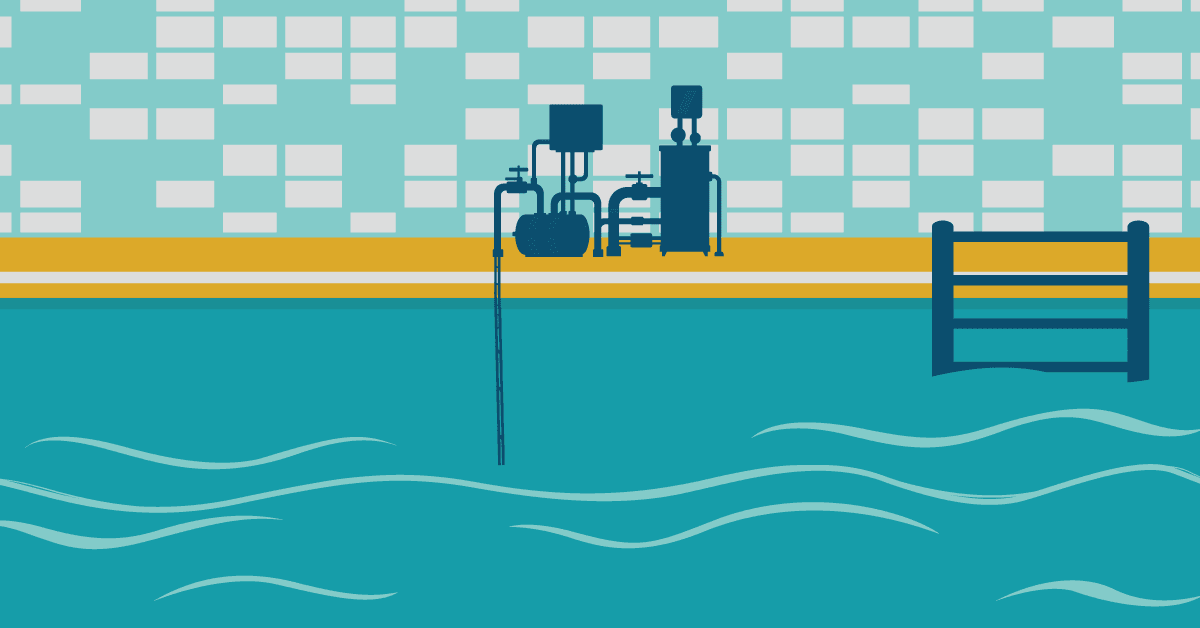Pool valves are a crucial component of any swimming pool because they allow you to control pool water flow in and out of your pool plumbing system. Making sure that your water flow is correctly going through your pool equipment is crucial.
This guide will teach you everything there is to know about pool valves so that you can make sure that yours are working properly all year round!
What Are Pool Valves?
Without the water in your pool circulating properly, you are risking damage to your pool.
Pool valves act as an outlet for excess water from pools – they allow water to flow into or away from the swimming pool through pipes connected to them. You’re also able to divert water from one area of the pool to another using these valves.
There are several different types of pool valves, and each has its own unique function. The most common internal components to pool valves for residential pools are a ball valve and gate valve (the latter is used when an anti-siphon isn’t needed).
Ball Valve vs. Gate Valve
A gate valve has one movable gate, which can either block or unblock water flow when rotated from an open position into a closed position and vice versa. The gate is usually positioned perpendicular to the pipe.
A ball valve is a type of valve that has a ball inside it that can rotate to block or unblock water flow when rotated from an open position into a closed position and vice versa.
How Do Pool Valves Work?
Pool valves work by being connected to a pool’s plumbing system.
These valves are used for manually shutting off or opening the pool water flow, all to make swimming easier and more convenient.
Valve actuators then communicate with these valves by sending signals to them, which tells them what action they need to take on their respective valve.

Types of Pool Valves
Understanding the different types of pool valves available is important because it can help you figure out which valve is best for your pool. We’re going to cover the most common types of valves used for pool plumbing below.
Multiport Valves
Multiport valves are usually found on your pool’s filter. It allows water to flow in any one allowed direction. This makes it a convenient option for pools with more than two filtration systems.
This valve is particularly useful when you want to vacuum your pool. You can also route water to be circulated without filtration and without using a booster pump.
Multiport valves are also found on the return side of your pool’s filter. This is where you’ll find four ports: one for in-line filtration and three to route water from various places back into the pool.
Backwash Valve
Another term used for a multiport valve on older models sometimes also called a slide valve, depending on your system. These are utilized to make sure you don’t send the water flowing backward through the filter. Flushing dirt and debris back into your pool is not good for your plumbing, pool filter, heater, or other water feature you may have.
Diverter Valve
As the name suggests, a pool diverter valve allows you to divert water flow to one of two places. This is useful for pool owners who want water flow in a certain area.
There are two types of pool diverter valves: 2-way valves and 3-way valves.
2-way valves control the water flow to or from a single port. You can think of this as a simple on or off switch. Because most of these valves have an adjustable handle, you can partially turn the flow on or off.
3-way valves control the water flow between three ports. This is usually used to turn on or off a skimmer or drain. These are also sometimes referred to as pool suction valves.
Diverter valves are arguably one of the most important components of a swimming pool. They control the water flow to and from various parts of your pool so you can optimize usage for maximum effect.
Check Valves
Pool check valves are designed to prevent pressure from one side of the valve (usually high pressure) from going back to a lower-pressure area.
Automatic Chlorinators
You should also have a check valve if you use an automatic pool chlorinator or a salt-chlorine generator. This prevents the backflow of water, so you don’t dump concentrated chlorine back into your other pool equipment, which could damage it.
Hot Tubs
If your pool and hot tub are connected – you will notice that the water level in your hot tub is higher than in the pool. When you turn the spa pump off, this prevents it from draining into the pool.
Water Features
For fountains and other water features, a check valve is usually attached to the pipe that leads from your pool or spa. It allows water through but prevents it from returning when the feature is turned off.
Solar Pool Heaters
If you’re utilizing a solar pool heater, you will need to install a check valve on the pipe leading to the solar panels. This is because the panels must always have water in them.
Valve Actuators
Valve actuators for pools are a relatively new development in the world of pool technology. These devices control the direction the water flows and when it flows into or out of your pool, depending on various factors such as input flow rate from an above-ground source like a garden hose.
Valve actuators for pools work by measuring how much pressure there is to activate in your system. By using a valve actuator, with the push of a button, you can turn on or off features without turning any valves yourself.
Shut Off Valve
A pool shut-off valve is a precisely engineered device that installs securely into the pool’s plumbing. This valve is designed to shut off the water flow in your pool from its source of origin, such as an outdoor or indoor faucet.
Pool shut-off valves are used to shut off water and turn on and open water flow when it has been closed. Another commonly used name for shut-off valves is gate valves since it’s like opening and closing a gate.
Butterfly Valve
Similar to a shut-off, a butterfly valve is used to throttle or prevent water from flowing freely. Instead of the mechanism going up or down through the pipe, a butterfly valve rotates internally in the valve.
How to Replace Pool Valves
When it comes time to replace your pool valve, it is important to first evaluate whether you can repair the current valve or if a replacement will be necessary. If your pool requires an unusual type of valve, then repairs may not be possible.
A broken seal on the inside of any appliance – including valves and pool filters – should always lead you to replace the whole device rather than attempting repairs because leaks may occur.
When to Replace a Pool Valve
How do you know when you need to replace vs. repair a pool valve? Great question.
If you are experiencing a leak and the plastic is visibly cracked, then it may be time to replace the valve. A failure in one of these pieces could lead to you pumping out your pool unintentionally into the yard.
Generally speaking, any broken seal on the inside of any appliance – including valves and filters – should always lead you to replace the whole device rather than attempting repairs because leaks can occur from this as well.
The Bottom Line
You now know everything there is to know about pool valves! Now you can confidently maintain your swimming pool and save money on expensive repairs. We hope this blog post has been helpful, as well as informative.

For over 15 years, Sean Moore has been sharing his love and enthusiasm for swimming pools and hot tubs with everyone he knows. His goal is to help everyday people DIY their maintenance to save money by teaching how to properly take care of your equipment, safely and correctly balance chemicals, and extend the life of your water oasis.


